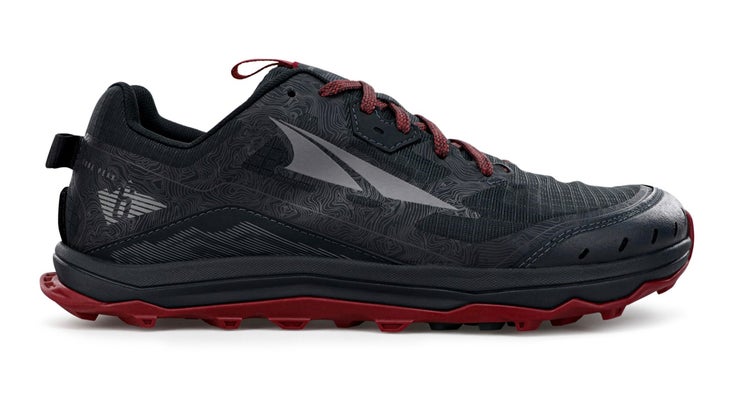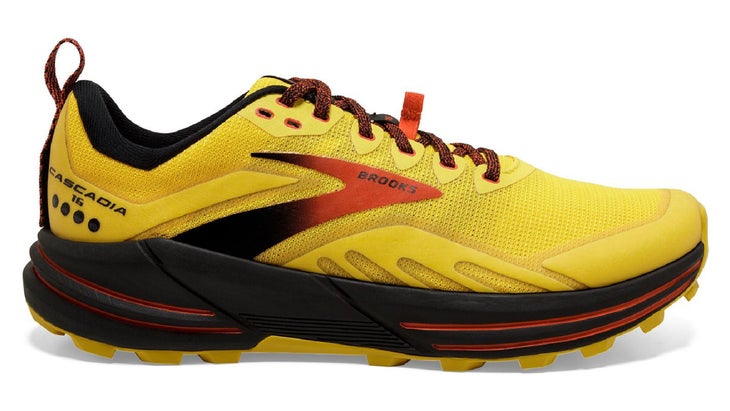Products You May Like
As trail running shoes have become the footwear of choice among long-distance trekkers, the range of offerings for backpacking-oriented models has exploded, too. While trail runners for backpacking range from minimalist shoes meant to mimic barefoot walking to maximally padded, pumped-up kicks, the bulk—and most of the best-selling models—exist somewhere in-between.
Two of the most popular trail running shoes, the Altra Lone Peak 6 and Brooks Cascadia 16, look very similar at first glance: They both have moderate cushioning, burly lugs for traction, and a mostly mesh construction. Both feature trail-specific perks like a gaiter tab, rock plate, and drainage holes to shed water. But on foot, the two models are markedly different, and which you prefer will depend on your hiking style, pack weight, and the shape of your foot. Read on to find out which shoe is best for you.

Altra Lone Peak 6
$140; 10.6 oz; Buy Now
In the 11 years since Altra first introduced it, the Lone Peak has become one of the most popular trail running shoes ever and a quintessential part of the thru-hiker’s uniform. The sixth iteration of the shoe stays true to the design elements that made it so well-loved in the first place: a generous toebox, soft but springy midsole, and zero-drop (flat from heel to forefoot) platform.
The latest model cuts half an ounce in weight compared to the fifth edition, thanks to slight changes in the upper. It fits a bit snugger through the midfoot, partly due to extra eyelets for lacing up. After several months of testing, we also found the upper to be more durable than previous models. The fine-weave mesh of the upper was breathable in hot weather, while also keeping trail dust and sand at bay.
The Lone Peak shines on long hikes with a lightweight backpack. Due to its zero-drop platform, it’s at its best when you avoid hard heel strikes, and we found that increasingly difficult as pack weights went up (it felt best underfoot with a 20- to 25-pound load). On tough scrambling routes in Idaho’s Sawtooth mountains, the ample toe room also made the Lone Peak feel a bit loose and squirrely when negotiating steep, rocky terrain, though the shoe’s in-house MaxTrac outsole was grippy on rocks and roots. The shoe was at its best during long hikes on moderate trails, where footing was simpler; the 25 mm stack height made for a comfortable ride, and the roomy toe box let our feet splay out naturally.
Go with the Altras if:
- You’ve whittled down your pack weight to 25 lbs or less.
- You often find your shoes feel tight or cause toe blisters.
- You want to focus on a mid-foot or “barefoot style” hiking gait.

Brooks Cascadia 16
$130; 10.5 oz; Buy Now
Before Altra’s surge in popularity, the Brooks Cascadia was the perennial favorite of thru-hikers. Even though it’s no longer the unquestioned favorite, there’s still plenty to like about the Cascadia, especially in its updated form. For starters, it’s both $10 cheaper and just a hair lighter than the Lone Peak, despite feeling like a more substantial and supportive shoe overall.
Like the Lone Peak, the latest model of the Cascadia is about a half-ounce lighter than its previous iteration. Its updated EVA foam midsole is softer, lighter, and 2 mm thicker than the Cascadia 15, and also feels springier underfoot compared to the Lone Peak. The upper features a more durable mesh, plus two extra eyelets near the ankle, a welcome addition for anyone looking for more support.
With a more supportive construction, the Cascadia is a great choice for people who carry heavier loads or walk with a more pronounced heel strike. Thanks to its 8 mm heel drop, the forward tilt of the Cascadia is immediately noticeable compared to the Lone Peak. On steep, staircase-like climbs in the White Mountains of New Hampshire with a 30-pound pack, the Cascadia’s heel lift proved a welcome bit of assistance. Measured against the Lone Peak, the Cascadia has a narrower toebox, creating a locked-in feeling that we appreciated in rough terrain (along with a slightly grippier outsole), but was constricting when the miles started to add up. Perhaps surprisingly, the Cascadia’s rock plate felt thinner and more flexible than the Lone Peak’s, and while the Cascadia’s heel felt more cushioned, the forefoot had more ground feel than the Lone Peak. We also found the Cascadia to be the overall more durable shoe, with a midsole that held up to 500 miles of abuse, roughly 100 more than the Lone Peak.
Go with the Brooks’ if:
- Your normal pack weight is 25 pounds or above.
- You prefer a shoe that feels snug and supportive.
- You plant your heels when you walk and don’t want to rethink your gait.
